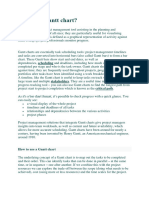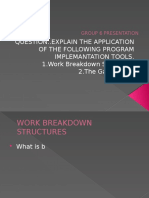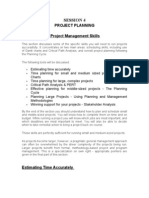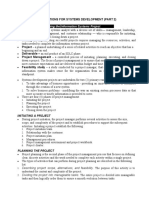Gantt Chart
Uploaded by
Reshma GeorgiGantt Chart
Uploaded by
Reshma GeorgiGANTT CHART
A Gantt chart is a type of bar chart that illustrates a project schedule. This chart lists the tasks to be
performed on the vertical axis and time intervals on the horizontal axis. The width of the horizontal bars
in the graph indicate the duration of the activity.
Gantt chart illustrates the start and finish dates of the terminal elements and summary elements of the
project. Terminal and summary elements constitute the Work Breakdown Structure of the project.
Modern Gantt charts also show the dependency relationships between activities. They can also be used
to show current schedule status using percent-complete shadings and a vertical ‘TODAY’ line.
Gantt charts are usually created initially using an early start time approach, where each task is scheduled
to start immediately when its pre-requisites are complete. This method maximizes the float time
available for all tasks.
Purpose of a Gantt chart
1. To illustrate the relationship between project activities and time.
2. To show multiple project activities on one chart.
3. To provide a simple and easy to understand representation of project scheduling.
Creating a Gantt chart
There are 2 methods to create a Gantt Chart:
1. Using a forward schedule: starting with the list of activities and a given start date; follow
them forwards in time until the given deadline.
2. Using a backward schedule: look at the deadline; from that date work in the logical list of
activities.
Steps to creating a Gantt Chart
1. Determine Project start date and deadline.
2. Gather all information surrounding the list of activities within a project- the project breakdown
structure may be useful for this.
3. Determine how long each activity will take.
4. Evaluate what activities are dependent on others.
5. Create graph shell including the time line and the list of activities.
6. Using either forward scheduling or backward scheduling begin to add bars ensuring to include
dependencies and the full duration for each activity.
Advantages:
1. A useful tool for displaying time-based information within a project.
2. Very simple to create.
3. They provide a useful overview of project activities, a good starting point for project planning.
4. They are widely used and understood.
5. There exist several PC software packages that allow you to build Gantt charts.
Limitations:
1. The Gantt chart doesn’t explain the reasoning behind the chosen duration of each activity.
2. The Gantt chart is very difficult to update when changes to the project plan take place. This
makes it time consuming and results in long term planning being difficult.
3. It encourages a one-step approach to planning- this prevents flexibility in project planning.
4. Modern day Gantt charts using PC software can look very professional without actually having
meaning, preventing project teams from challenging their content. This can lead to difficulties
later in the project.
5. They are difficult to update manually and can often become obsolete.
6. The chart doesn’t compare project resources and cost
Example:
Consider the following:
Gantt chart
You might also like
- Gantt Chart: The Theory of Henry Laurence GanttNo ratings yetGantt Chart: The Theory of Henry Laurence Gantt14 pages
- Project-Management: Construction of GV Towers, BengaluruNo ratings yetProject-Management: Construction of GV Towers, Bengaluru14 pages
- Seminar On Programme Evaluation and Review Technique, Gantt Chart and Management by Objective100% (1)Seminar On Programme Evaluation and Review Technique, Gantt Chart and Management by Objective14 pages
- Question..Explain The Application of The Following Program Implemantation Tools. 1.work Breakdown Structures 2.the Gantt Chart 3.budgetNo ratings yetQuestion..Explain The Application of The Following Program Implemantation Tools. 1.work Breakdown Structures 2.the Gantt Chart 3.budget14 pages
- Advantages of Gantt Charts: Mavenlink Wrike Smartsheet AceprojectNo ratings yetAdvantages of Gantt Charts: Mavenlink Wrike Smartsheet Aceproject4 pages
- Engr. Jeffrey T. Dellosa Information and Communications Technology (ICT) Center NormisistNo ratings yetEngr. Jeffrey T. Dellosa Information and Communications Technology (ICT) Center Normisist60 pages
- Assignment - 3 - Pert and CPM and Bar ChartNo ratings yetAssignment - 3 - Pert and CPM and Bar Chart6 pages
- 04.project Execution Running The ProjectNo ratings yet04.project Execution Running The Project70 pages
- Displaying the Critical Path on a Gantt Chart - ProjectManagerNo ratings yetDisplaying the Critical Path on a Gantt Chart - ProjectManager12 pages
- Using Gantt Chart To Kickstart A Project PDFNo ratings yetUsing Gantt Chart To Kickstart A Project PDF5 pages
- Planning & Scheduling Systems: From Design To FabricationNo ratings yetPlanning & Scheduling Systems: From Design To Fabrication32 pages
- Network Techniques For Project Management: StructureNo ratings yetNetwork Techniques For Project Management: Structure15 pages
- Interpret The Network Figures Use in Civil Engineering.: Tools For Project SchedulingNo ratings yetInterpret The Network Figures Use in Civil Engineering.: Tools For Project Scheduling13 pages
- Ultimate Guide To Scheduling - ProjectManagerNo ratings yetUltimate Guide To Scheduling - ProjectManager32 pages
- Mobility For All: The Rights Perspective: Anjlee Agarwal, Debabrata Chakravarti and Nidhi MadanNo ratings yetMobility For All: The Rights Perspective: Anjlee Agarwal, Debabrata Chakravarti and Nidhi Madan11 pages
- Summary of Postmodernism and Consumer Society75% (4)Summary of Postmodernism and Consumer Society2 pages
- Methods, Tools and Instruments For Use With Children: Young Lives Technical Note NoNo ratings yetMethods, Tools and Instruments For Use With Children: Young Lives Technical Note No56 pages
- Patch-Corridor-Matrix Model (: Model (Forman 1995) - Under This Model, Three Major Landscape Elements Are TypicallyNo ratings yetPatch-Corridor-Matrix Model (: Model (Forman 1995) - Under This Model, Three Major Landscape Elements Are Typically4 pages
- Howard T. Odum: Stability Teleology Systems Natural Selection EmpiricalNo ratings yetHoward T. Odum: Stability Teleology Systems Natural Selection Empirical2 pages
- Parvathy Puthanar Canal To Get A New Lease of Life - Times of IndiaNo ratings yetParvathy Puthanar Canal To Get A New Lease of Life - Times of India2 pages
- Dying A Social Perspective On The End of Life Alex Broom Download PDF100% (8)Dying A Social Perspective On The End of Life Alex Broom Download PDF65 pages
- Account Statement: Tizar Infra Projects Private Limited NO. 95 Palayam Bazaar Woraiyur TiruchirappalliNo ratings yetAccount Statement: Tizar Infra Projects Private Limited NO. 95 Palayam Bazaar Woraiyur Tiruchirappalli2 pages
- Lower Level Upper Level: Men's and Home Men's and HomeNo ratings yetLower Level Upper Level: Men's and Home Men's and Home1 page
- Coherence in The Quran and A Brief Analysis of Sura Al BaqarahNo ratings yetCoherence in The Quran and A Brief Analysis of Sura Al Baqarah52 pages
- Lexber Inc. V Sps. Dalman G.R. No. 183587, April 20, 2015No ratings yetLexber Inc. V Sps. Dalman G.R. No. 183587, April 20, 201514 pages
- Chemistry Criterion D: Chemical Compounds in Daily Life 1No ratings yetChemistry Criterion D: Chemical Compounds in Daily Life 13 pages
- U of H Open Records Complaint To Texas Attorney GeneralNo ratings yetU of H Open Records Complaint To Texas Attorney General21 pages
- En Collection of Data Sheets MPS PA 090804No ratings yetEn Collection of Data Sheets MPS PA 090804194 pages
- Toxic Masculinity and Gender Equity in The Australian Defence ForceNo ratings yetToxic Masculinity and Gender Equity in The Australian Defence Force3 pages
- Atashi No Onii-Chan Dekita! Onii-Chan7313No ratings yetAtashi No Onii-Chan Dekita! Onii-Chan73131 page
- Critical Success Factors in Projects PinNo ratings yetCritical Success Factors in Projects Pin20 pages
- GMAT and GMAT Waiver Fact Sheet Updated 3-10-16 Read OnlyNo ratings yetGMAT and GMAT Waiver Fact Sheet Updated 3-10-16 Read Only3 pages
- Published by - Bapi Saha, Mobile-9088857120No ratings yetPublished by - Bapi Saha, Mobile-90888571204 pages







































































































